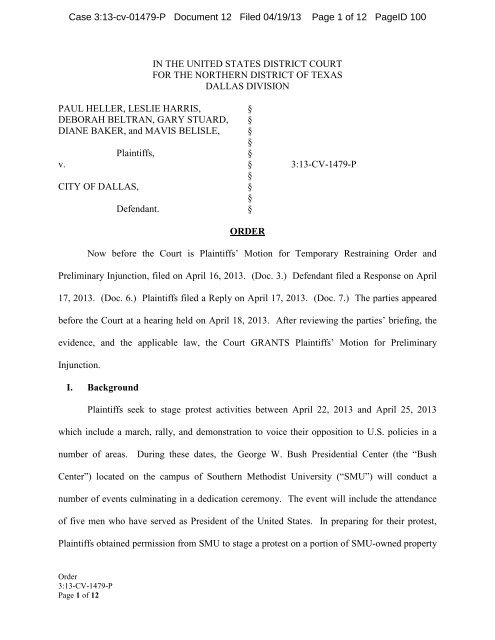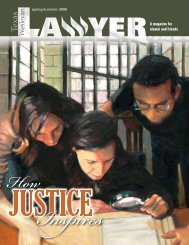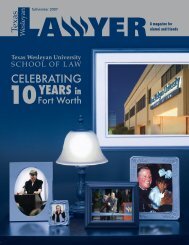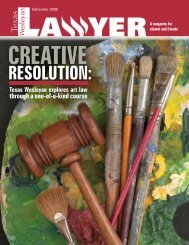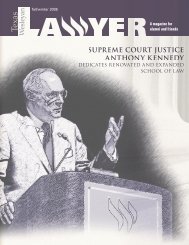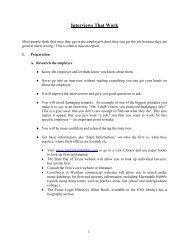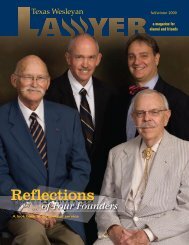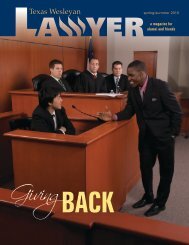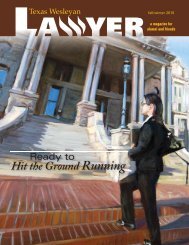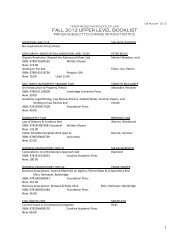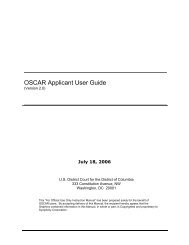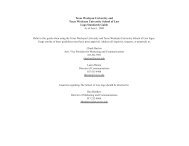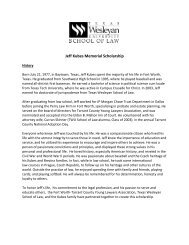View the Heller v. City of Dallas opinion here
View the Heller v. City of Dallas opinion here
View the Heller v. City of Dallas opinion here
Create successful ePaper yourself
Turn your PDF publications into a flip-book with our unique Google optimized e-Paper software.
Case 3:13-cv-01479-P Document 12 Filed 04/19/13 Page 1 <strong>of</strong> 12 PageID 100<br />
Order<br />
3:13-CV-1479-P<br />
Page 1 <strong>of</strong> 12<br />
IN THE UNITED STATES DISTRICT COURT<br />
FOR THE NORTHERN DISTRICT OF TEXAS<br />
DALLAS DIVISION<br />
PAUL HELLER, LESLIE HARRIS, §<br />
DEBORAH BELTRAN, GARY STUARD, §<br />
DIANE BAKER, and MAVIS BELISLE, §<br />
§<br />
Plaintiffs, §<br />
v. § 3:13-CV-1479-P<br />
§<br />
CITY OF DALLAS, §<br />
§<br />
Defendant. §<br />
ORDER<br />
Now before <strong>the</strong> Court is Plaintiffs’ Motion for Temporary Restraining Order and<br />
Preliminary Injunction, filed on April 16, 2013. (Doc. 3.) Defendant filed a Response on April<br />
17, 2013. (Doc. 6.) Plaintiffs filed a Reply on April 17, 2013. (Doc. 7.) The parties appeared<br />
before <strong>the</strong> Court at a hearing held on April 18, 2013. After reviewing <strong>the</strong> parties’ briefing, <strong>the</strong><br />
evidence, and <strong>the</strong> applicable law, <strong>the</strong> Court GRANTS Plaintiffs’ Motion for Preliminary<br />
Injunction.<br />
I. Background<br />
Plaintiffs seek to stage protest activities between April 22, 2013 and April 25, 2013<br />
which include a march, rally, and demonstration to voice <strong>the</strong>ir opposition to U.S. policies in a<br />
number <strong>of</strong> areas. During <strong>the</strong>se dates, <strong>the</strong> George W. Bush Presidential Center (<strong>the</strong> “Bush<br />
Center”) located on <strong>the</strong> campus <strong>of</strong> Sou<strong>the</strong>rn Methodist University (“SMU”) will conduct a<br />
number <strong>of</strong> events culminating in a dedication ceremony. The event will include <strong>the</strong> attendance<br />
<strong>of</strong> five men who have served as President <strong>of</strong> <strong>the</strong> United States. In preparing for <strong>the</strong>ir protest,<br />
Plaintiffs obtained permission from SMU to stage a protest on a portion <strong>of</strong> SMU-owned property
Case 3:13-cv-01479-P Document 12 Filed 04/19/13 Page 2 <strong>of</strong> 12 PageID 101<br />
(“Expressway Tower”) located at 6116 Central Expressway. 1 Although this space lies on <strong>the</strong><br />
east side <strong>of</strong> <strong>the</strong> Central Expressway, <strong>the</strong> proposed protest area affords Plaintiffs a direct line <strong>of</strong><br />
sight to <strong>the</strong> Bush Center. 2 This location is important to Plaintiffs because <strong>the</strong> planned<br />
demonstrations are being held in connection with <strong>the</strong> events surrounding <strong>the</strong> dedication <strong>of</strong> <strong>the</strong><br />
Bush Center.<br />
Order<br />
3:13-CV-1479-P<br />
Page 2 <strong>of</strong> 12<br />
In planning for <strong>the</strong>ir protest activities at Expressway Tower, Plaintiffs contacted <strong>the</strong><br />
<strong>Dallas</strong> Police Department in order to verify that <strong>the</strong>ir conduct would not subject <strong>the</strong>m to citation<br />
or o<strong>the</strong>r sanction. Members <strong>of</strong> <strong>the</strong> <strong>Dallas</strong> Police Department informed Plaintiffs that holding any<br />
sign on <strong>the</strong> sidewalk at or near Expressway Tower would constitute a violation <strong>of</strong> Section 28-<br />
158.1 <strong>of</strong> <strong>the</strong> <strong>Dallas</strong> <strong>City</strong> Code (“<strong>the</strong> Ordinance”). The Ordinance states:<br />
A person commits an <strong>of</strong>fense if he carries or o<strong>the</strong>rwise displays a<br />
sign 3 on, over, or within 75 feet <strong>of</strong> <strong>the</strong> roadway <strong>of</strong> any <strong>of</strong> <strong>the</strong><br />
following streets or highways in a manner intended to attract <strong>the</strong><br />
attention <strong>of</strong> vehicle occupants on those streets or highways. 4<br />
<strong>Dallas</strong>, Tex., Code § 28-158.1(b).<br />
In particular, Plaintiffs learned that <strong>the</strong>y would be issued a citation if <strong>the</strong>y held signs<br />
within seventy-five feet or less <strong>of</strong> <strong>the</strong> access road running northbound on <strong>the</strong> Central<br />
Expressway. <strong>Dallas</strong> police <strong>of</strong>ficers fur<strong>the</strong>r noted that Plaintiffs would be able to hold signs in<br />
protest so long as <strong>the</strong>y stood more than seventy-five feet from <strong>the</strong> access road, which would<br />
place <strong>the</strong>m at or near <strong>the</strong> parking lot <strong>of</strong> Expressway Tower, ra<strong>the</strong>r than on <strong>the</strong> sidewalk adjacent<br />
to <strong>the</strong> Central Expressway access road.<br />
1<br />
Central Expressway is a locally-known alternative name for certain portions <strong>of</strong> U.S. 75.<br />
2<br />
Several streets and roads on <strong>the</strong> west side <strong>of</strong> central expressway near <strong>the</strong> Bush Center will be inaccessible during<br />
its opening due to ei<strong>the</strong>r security concerns or crowd-control.<br />
3<br />
The Ordinance defines a sign as “any device, flag, light, figure, picture, letter, word, message, symbol, plaque,<br />
poster, or o<strong>the</strong>r thing that is designed, used, or intended to advertise or inform.” <strong>Dallas</strong>, Tex., Code § 28-158.1(a).<br />
4<br />
The Ordinance contains a specifically enumerated list <strong>of</strong> highways to which it applies, including Central<br />
Expressway. <strong>Dallas</strong>, Tex., Code § 28-158.1(b).
Case 3:13-cv-01479-P Document 12 Filed 04/19/13 Page 3 <strong>of</strong> 12 PageID 102<br />
Order<br />
3:13-CV-1479-P<br />
Page 3 <strong>of</strong> 12<br />
On April 11, 2013, Plaintiffs filed suit against Defendant <strong>City</strong> <strong>of</strong> <strong>Dallas</strong> (“<strong>the</strong> <strong>City</strong>”) and<br />
sought a Temporary Restraining Order and Preliminary Injunction declaring <strong>the</strong> Ordinance<br />
unconstitutional on its face and as applied to Plaintiffs. Following <strong>the</strong> <strong>City</strong>’s removal <strong>of</strong> this<br />
action on April 16, 2013, <strong>the</strong> Court expedited <strong>the</strong> briefing on <strong>the</strong> preliminary injunction and held<br />
a hearing on April 18, 2013.<br />
II. Jurisdiction<br />
In a separately filed Motion, Plaintiffs have moved to remand this matter to state court,<br />
arguing that <strong>the</strong> <strong>City</strong> improperly removed from state court. (Doc. 5.) A defendant may remove a<br />
suit from state court to federal court only if <strong>the</strong> action could have originally been filed in federal<br />
court. 28 U.S.C. § 1441(a). In this case, <strong>the</strong> <strong>City</strong> filed a Notice <strong>of</strong> Removal and claimed that<br />
federal question jurisdiction arises from Plaintiff’s cause <strong>of</strong> action under 42 U.S.C. § 1983.<br />
(Doc. 1 at 5-6.) The Court finds that this is an adequate showing so as to confer jurisdiction <strong>of</strong><br />
this First Amendment case. 5<br />
III. Preliminary Injunction<br />
Federal Rule <strong>of</strong> Civil Procedure 65 provides that <strong>the</strong> Court may issue a preliminary<br />
injunction to restrain or require certain acts. For <strong>the</strong> grant <strong>of</strong> injunctive relief, a movant must<br />
demonstrate <strong>the</strong> following equitable factors: “(1) a substantial likelihood <strong>of</strong> success on <strong>the</strong><br />
5 Plaintiffs have also noted that <strong>the</strong>y are defendants in an ongoing criminal trial in <strong>Dallas</strong> Municipal Court for<br />
previous violations <strong>of</strong> <strong>the</strong> Ordinance. (Doc. 5 at 2.) As part <strong>of</strong> this suit, Plaintiffs state that on January 21, 2013<br />
<strong>the</strong>y were engaged in “a peaceful rally in favor <strong>of</strong> <strong>the</strong> First Amendment at <strong>the</strong> intersection <strong>of</strong> Mockingbird Lane and<br />
Central Expressway.” (Doc. 1 at 17.) Plaintiffs state <strong>the</strong>y were given citations under <strong>the</strong> Ordinance by members <strong>of</strong><br />
<strong>the</strong> <strong>Dallas</strong> Police Department and were told <strong>the</strong>y would be arrested if <strong>the</strong>y did not lower or cover <strong>the</strong>ir signs. (Id.)<br />
Plaintiffs have raised a defense <strong>of</strong> <strong>the</strong> unconstitutionality <strong>of</strong> <strong>the</strong> Ordinance in <strong>the</strong> criminal proceedings. According<br />
to Plaintiffs, <strong>the</strong> <strong>City</strong> Municipal Judge is holding <strong>the</strong> criminal case in abeyance pending <strong>the</strong> outcome <strong>of</strong> this suit. As<br />
a result, Plaintiffs have asked <strong>the</strong> Court to abstain pursuant to Younger v. Harris, 401 U.S. 37 (1971). (Id. at 3.) In<br />
<strong>the</strong> instant ruling, <strong>the</strong> Court is ruling only on <strong>the</strong> Plaintiffs’ request for declaratory and injunctive relief regarding<br />
<strong>the</strong>ir planned activities in connection with <strong>the</strong> opening and dedication <strong>of</strong> <strong>the</strong> George W. Bush Library on April 22-<br />
25, 2013. This Order expresses no <strong>opinion</strong> on <strong>the</strong> Ordinance regarding <strong>the</strong> citations given to Plaintiffs on January<br />
21, 2013, as it occurred in a different location and was not a protest conducted in connection with <strong>the</strong> opening <strong>of</strong> <strong>the</strong><br />
Bush Center.
Case 3:13-cv-01479-P Document 12 Filed 04/19/13 Page 4 <strong>of</strong> 12 PageID 103<br />
merits, (2) a substantial threat <strong>of</strong> irreparable injury if <strong>the</strong> injunction is not issued, (3) <strong>the</strong><br />
threatened injury if <strong>the</strong> injunction is denied outweighs any harm that will result if <strong>the</strong> injunction<br />
is granted, and (4) <strong>the</strong> grant <strong>of</strong> <strong>the</strong> injunction will not disserve <strong>the</strong> public interest.” Janvey v.<br />
Alguire, 647 F.3d 585, 595 (5th Cir. 2011) (citing Byrum v. Landreth, 566 F.3d 442, 445 (5th<br />
Cir. 2009)). “A preliminary injunction is an extraordinary remedy.” La Union del Pueblo<br />
Entero v. FEMA, 608 F.3d 217, 219 (5th Cir. 2010). “The purpose <strong>of</strong> a preliminary injunction is<br />
merely to preserve <strong>the</strong> relative positions <strong>of</strong> <strong>the</strong> parties until a trial on <strong>the</strong> merits can be held.”<br />
Univ. <strong>of</strong> Tex. v. Camenisch, 451 U.S. 390, 395 (1981). Thus, “a preliminary injunction is<br />
customarily granted on <strong>the</strong> basis <strong>of</strong> procedures that are less formal and evidence that is less<br />
complete than in a trial on <strong>the</strong> merits.” Id. The Court may accept o<strong>the</strong>rwise inadmissible<br />
evidence, including hearsay evidence, “in <strong>the</strong> form <strong>of</strong> deposition transcripts and affidavits.”<br />
Sierra Club, Lone Star Chapter v. F.D.I.C., 992 F.2d 545, 551 (5th Cir. 1993).<br />
Order<br />
3:13-CV-1479-P<br />
Page 4 <strong>of</strong> 12<br />
A. Success on <strong>the</strong> Merits<br />
Government Interest<br />
Regardless <strong>of</strong> whe<strong>the</strong>r <strong>the</strong> Ordinance is content-based or content-neutral, <strong>the</strong> <strong>City</strong> must<br />
demonstrate that it has some meaningful interest in more stringent regulation <strong>of</strong> traffic at or near<br />
<strong>the</strong> sidewalk <strong>of</strong> Expressway Tower. Courts use varying standards in evaluating <strong>the</strong> propriety <strong>of</strong><br />
government regulation <strong>of</strong> free speech. The most demanding standard <strong>of</strong> review is known as<br />
strict scrutiny, w<strong>here</strong>upon <strong>the</strong> government must demonstrate that “<strong>the</strong> restriction [is] narrowly<br />
tailored to serve a compelling government interest.” Christian Legal Soc'y Chapter <strong>of</strong> <strong>the</strong> Univ.<br />
<strong>of</strong> Cal., Hastings Coll. <strong>of</strong> <strong>the</strong> Law v. Martinez, --U.S.--, 130 S.Ct. 2971, 2984 n. 11 (2010)<br />
(emphasis added). W<strong>here</strong> a regulation is content-neutral and restricts <strong>the</strong> time, place, and<br />
manner <strong>of</strong> speech, courts apply intermediate scrutiny, which requires <strong>the</strong> government to
Case 3:13-cv-01479-P Document 12 Filed 04/19/13 Page 5 <strong>of</strong> 12 PageID 104<br />
demonstrate that <strong>the</strong> regulation (1) serves a significant governmental interest, (2) is narrowly<br />
tailored to achieve that interest, and (3) leaves open ample alternative channels <strong>of</strong><br />
communication. Ward v. Rock Against Racism, 491 U.S. 781, 791 (1989) (emphasis added)<br />
(citing Clark v. Cmty. for Creative Non–Violence, 468 U.S. 288, 293 (1984)); Consol. Edison<br />
Co. <strong>of</strong> N.Y. v. Pub. Serv. Comm'n <strong>of</strong> N.Y., 447 U.S. 530, 535–36 (1980). Considering <strong>the</strong><br />
available tests, a showing <strong>of</strong> only a minimal government interest will not withstand a challenge<br />
on First Amendment grounds. See e.g. Bd. <strong>of</strong> Airport Comm'rs v. Jews for Jesus, 482 U.S. 569,<br />
575 (1987); Metromedia, Inc. v. <strong>City</strong> <strong>of</strong> San Diego, 453 U.S. 490, 502 (1981) (plurality <strong>opinion</strong>);<br />
Stay <strong>the</strong> Course W. Va. v. Tennant, No. 1:12-CV-01658, 2012 U.S. Dist. LEXIS 112147, at *17-<br />
18 (S.D. W. Va. Aug. 9, 2012). Under <strong>the</strong> facts <strong>of</strong> this case, <strong>the</strong> interest articulated by <strong>the</strong> <strong>City</strong><br />
would have to be ei<strong>the</strong>r compelling or significant. Based upon <strong>the</strong> evidence submitted at <strong>the</strong><br />
preliminary injunction hearing, <strong>the</strong>re is inadequate evidence <strong>of</strong> ei<strong>the</strong>r a significant government<br />
interest or a compelling government interest in more rigorous signage regulation at <strong>the</strong> specific<br />
area w<strong>here</strong> Plaintiffs seek to protest.<br />
Order<br />
3:13-CV-1479-P<br />
Page 5 <strong>of</strong> 12<br />
Upon considering <strong>the</strong> evidence presented at <strong>the</strong> preliminary injunction hearing, <strong>the</strong> Court<br />
finds that <strong>the</strong> <strong>City</strong> has failed to demonstrate any need to regulate signs and o<strong>the</strong>r displays at or<br />
near <strong>the</strong> proposed protest venue as strictly as outlined in <strong>the</strong> Ordinance. In its most general,<br />
abstract form, <strong>the</strong> Ordinance serves <strong>the</strong> interest <strong>of</strong> <strong>the</strong> <strong>City</strong> in ensuring traffic safety.<br />
Metromedia, Inc., 453 U.S. at 507–08 (describing traffic safety as one <strong>of</strong> a municipalities<br />
“substantial governmental goals”). This interest would be especially important along<br />
traditionally-defined multi-lane highways, which involve motorists traveling at a high rate <strong>of</strong><br />
speed, in frequently changing lanes, entering, or exiting <strong>the</strong> roadway. However, <strong>the</strong> <strong>City</strong> has<br />
failed to adequately and particularly demonstrate that <strong>the</strong> traffic along <strong>the</strong> service road near <strong>the</strong>
Case 3:13-cv-01479-P Document 12 Filed 04/19/13 Page 6 <strong>of</strong> 12 PageID 105<br />
proposed protest venue is in any way different from any busy streets which do not fall within <strong>the</strong><br />
Ordinance’s ambit.<br />
Order<br />
3:13-CV-1479-P<br />
Page 6 <strong>of</strong> 12<br />
The stretch <strong>of</strong> <strong>the</strong> northbound service road between Mockingbird Lane and SMU<br />
Boulevard is approximately 1,500 feet. Google Maps, http://maps.google.com (search term<br />
“6116 North Central Expressway”). This stretch <strong>of</strong> roadway contains no on-ramps or <strong>of</strong>f-ramps<br />
to and from <strong>the</strong> main highway portion <strong>of</strong> <strong>the</strong> Central Expressway. Id. Traffic signals regulate<br />
traffic flow at both <strong>the</strong> sou<strong>the</strong>rnmost intersection <strong>of</strong> this stretch and <strong>the</strong> nor<strong>the</strong>rnmost intersection<br />
<strong>of</strong> this particular stretch <strong>of</strong> roadway. Id. Plaintiffs submitted video evidence suggesting that this<br />
particular access road is significantly elevated above <strong>the</strong> main highway thoroughfare and entirely<br />
out <strong>of</strong> its view, and this evidence was not rebutted by <strong>the</strong> <strong>City</strong>. No evidence suggests that traffic<br />
near <strong>the</strong> site is moving at a rate <strong>of</strong> speed greater than forty miles per hour. 6 Traffic along <strong>the</strong><br />
service road is limited to two lanes, w<strong>here</strong>as Central Expressway contains three to four lanes in<br />
each direction. Fur<strong>the</strong>rmore, <strong>the</strong> proposed location is near an ordinary traffic intersection—<br />
complete with a stop light—that more closely functions as does any ordinary intersection located<br />
within <strong>the</strong> <strong>Dallas</strong> <strong>City</strong> limits w<strong>here</strong> displaying a sign is not a citable <strong>of</strong>fense under <strong>the</strong> Ordinance.<br />
Factually, <strong>the</strong> area in which Plaintiffs seek to display <strong>the</strong>ir signs is more analogous to a<br />
commercial setting than it is a highway setting.<br />
Noting <strong>the</strong>se unrebutted facts, <strong>the</strong> Court finds that <strong>the</strong> government has failed to meet its<br />
burden to demonstrate even a minimal need to regulate First Amendment activity at or near <strong>the</strong><br />
proposed protest site any differently than any o<strong>the</strong>r street w<strong>here</strong> Plaintiffs would not be subject<br />
to citation under <strong>the</strong> Ordinance for bearing a sign. Finding that <strong>the</strong> government interests<br />
6<br />
Testimony received during <strong>the</strong> preliminary injunction hearing suggests that <strong>the</strong> normal speed limit in this specific<br />
stretch is thirty-five miles per hour.
Case 3:13-cv-01479-P Document 12 Filed 04/19/13 Page 7 <strong>of</strong> 12 PageID 106<br />
advanced by <strong>the</strong> <strong>City</strong> are not implicated at this location, <strong>the</strong> Court finds that Plaintiffs have<br />
shown a substantial likelihood <strong>of</strong> success on <strong>the</strong> merits.<br />
Order<br />
3:13-CV-1479-P<br />
Page 7 <strong>of</strong> 12<br />
Vagueness<br />
The <strong>City</strong> has taken <strong>the</strong> position that <strong>the</strong> term “Central Expressway” in <strong>the</strong> Ordinance<br />
includes not only <strong>the</strong> main traffic lanes <strong>of</strong> <strong>the</strong> highway itself, but also all <strong>of</strong> its access and/or<br />
service roads. Claiming that <strong>the</strong> Ordinance is constitutionally void for vagueness, Plaintiffs<br />
argue that <strong>the</strong> Ordinance does not sufficiently apprise <strong>the</strong>m as to w<strong>here</strong> <strong>the</strong>y may hold <strong>the</strong>ir signs<br />
during <strong>the</strong>ir planned protest. (Doc. 7 at 19-20.) Regulation <strong>of</strong> speech must be through laws<br />
whose prohibitions are clear. Flexibility in a statute is permissible, but <strong>the</strong> statute must provide<br />
“fair notice” so that its prohibitions may be avoided by those who wish to do so. Grayned v. <strong>City</strong><br />
<strong>of</strong> Rockford, 408 U.S. 104, 110-12 (1972). Vagueness challenges usually must show that <strong>the</strong> law<br />
has a capacity “to chill constitutionally protected conduct, especially conduct protected by <strong>the</strong><br />
First Amendment.” Roark & Hardee LP v. <strong>City</strong> <strong>of</strong> Austin, 522 F.3d 533, 546 (5th Cir. 2008)<br />
(quoting United States v. Gaudreau, 860 F.2d 357, 360 (10th Cir. 1988)).<br />
For criminal statutes, <strong>the</strong> Fifth Circuit uses a two-part void-for-vagueness test: (1) a penal<br />
statute must define <strong>the</strong> criminal <strong>of</strong>fense with sufficient definiteness so that an ordinary person<br />
may understand what conduct is actually prohibited; and (2) a penal statute must define a<br />
criminal <strong>of</strong>fense in a way that does not encourage discriminatory and arbitrary enforcement.<br />
United States v. Rudzavice, 586 F.3d 310, 314–15 (5th Cir. 2009) (quoting Kolender v. Lawson,<br />
461 U.S. 352, 357 (1983)); Ford Motor Co. v. Tex. Dep't <strong>of</strong> Transp., 264 F.3d 493, 507 (5th Cir.<br />
2001). “But perfect clarity and precise guidance have never been required even <strong>of</strong> regulations<br />
that restrict expressive activity.” United States v. Williams, 553 U.S. 285, 304 (2008) (quoting<br />
Ward, 491 U.S. at 794).
Case 3:13-cv-01479-P Document 12 Filed 04/19/13 Page 8 <strong>of</strong> 12 PageID 107<br />
Order<br />
3:13-CV-1479-P<br />
Page 8 <strong>of</strong> 12<br />
Having examined both <strong>the</strong> Ordinance itself and <strong>the</strong> evidence presented at <strong>the</strong> preliminary<br />
injunction hearing, <strong>the</strong> Court preliminarily finds that ample support exists to permit a preliminary<br />
finding that <strong>the</strong> Ordinance is unconstitutionally vague and <strong>the</strong>refore void. First, <strong>the</strong> plain<br />
language <strong>of</strong> <strong>the</strong> Ordinance itself does not contain any reference to <strong>the</strong> terms access road or<br />
service road. 7 To support its position that <strong>the</strong> Ordinance includes service and access road<br />
portions <strong>of</strong> Central Expressway, <strong>the</strong> <strong>City</strong> has cited <strong>the</strong> General Provisions portion <strong>of</strong> <strong>the</strong> <strong>Dallas</strong><br />
<strong>City</strong> Code, which defines a highway as:<br />
identified as:<br />
…any street, alley, highway, avenue or public place or square,<br />
bridges, viaducts, tunnels, underpasses, overpasses and causeways<br />
in <strong>the</strong> city, dedicated or devoted to public use. <strong>Dallas</strong>, Tex., Code<br />
§ 1-5.<br />
Fur<strong>the</strong>r confusing <strong>the</strong> issue is <strong>the</strong> <strong>Dallas</strong> <strong>City</strong> Code’s definition <strong>of</strong> a roadway, which is<br />
…that portion <strong>of</strong> a street improved, designed or ordinarily used for<br />
vehicular traffic and that portion <strong>of</strong> a street used for drainage. Id.<br />
Yet ano<strong>the</strong>r definition contained in <strong>the</strong> <strong>Dallas</strong> <strong>City</strong> code notes that a street includes:<br />
…any highway, boulevard, alley, street, avenue or public place or<br />
square, bridges, viaducts, culverts, underpasses, overpasses,<br />
tunnels and causeways in <strong>the</strong> city, dedicated to or devoted to public<br />
use. Id.<br />
These definitions flow in an entirely circular fashion, many containing identical language<br />
or portions <strong>of</strong> o<strong>the</strong>r definitions, as is <strong>the</strong> case with <strong>the</strong> definition <strong>of</strong> a highway and a street. Each<br />
definition uses <strong>the</strong> very term it defines in <strong>the</strong> definition section. Notably, none <strong>of</strong> <strong>the</strong>se<br />
definitions clearly or adequately suggest that a highway includes both <strong>the</strong> main thoroughfare as<br />
7 Evidence in <strong>the</strong> record suggests that service roads are unique to Texas highways. Recognizing this fact, a<br />
statutorily defined term such as “highway” would need to account for this feature when regulating which conduct<br />
may occur in certain areas near <strong>the</strong> road.
Case 3:13-cv-01479-P Document 12 Filed 04/19/13 Page 9 <strong>of</strong> 12 PageID 108<br />
well as all <strong>of</strong> its access and/or service roads. Applying this understanding to Plaintiffs and o<strong>the</strong>r<br />
putative sign-bearers along <strong>the</strong> Central Expressway, <strong>the</strong> Court is not convinced that an ordinary<br />
person <strong>of</strong> even extraordinary intelligence would understand that <strong>the</strong> restricted seventy-five foot<br />
sign-free zone actually begins from <strong>the</strong> outside sidewalk <strong>of</strong> Central Expressway’s access road.<br />
Order<br />
3:13-CV-1479-P<br />
Page 9 <strong>of</strong> 12<br />
The vagueness <strong>of</strong> <strong>the</strong> Ordinance also encourages its improper enforcement. As noted<br />
above, a penal statute must define a criminal <strong>of</strong>fense in a way that does not encourage<br />
discriminatory and arbitrary enforcement. During <strong>the</strong> preliminary injunction hearing, <strong>the</strong> Court<br />
received evidence that even those tasked with enforcing <strong>the</strong> ordinance struggled to uniformly<br />
apply its plain terms. On cross-examination, Chief Shedd, head <strong>of</strong> <strong>the</strong> <strong>Dallas</strong> Police Department<br />
division tasked with enforcement <strong>of</strong> <strong>the</strong> Ordinance, demonstrated noticeable discomfort and<br />
confusion when presented with several hypo<strong>the</strong>tical situations 8 regarding display <strong>of</strong> signage<br />
along <strong>the</strong> sidewalk <strong>of</strong> <strong>the</strong> Central Expressway service road. Many <strong>of</strong> Chief Shedd’s answers to<br />
<strong>the</strong>se hypo<strong>the</strong>ticals were ei<strong>the</strong>r unresponsive or inconsistent. Fur<strong>the</strong>rmore, o<strong>the</strong>r evidence<br />
suggests that <strong>the</strong> Plaintiffs specifically asked <strong>Dallas</strong> Police Department <strong>of</strong>ficers if <strong>the</strong>y would be<br />
cited under <strong>the</strong> Ordinance if <strong>the</strong>y were to stand with <strong>the</strong>ir backs facing <strong>the</strong> Central Expressway<br />
access road with <strong>the</strong>ir signs facing <strong>the</strong> parking lot, not oncoming traffic, to take a photograph.<br />
<strong>Dallas</strong> Police Department <strong>of</strong>ficers stated that this would be a violation and that such conduct<br />
would subject Plaintiffs to citation. 9 During her testimony, Chief Shedd stated that she did not<br />
believe that this would be a violation.<br />
8 The hypo<strong>the</strong>tical situations were not difficult to imagine as having actually occurred, such as football fans bearing<br />
signs while on <strong>the</strong>ir way to Ford Stadium on <strong>the</strong> SMU campus or signs left unattended at <strong>the</strong> proposed protest site.<br />
9 The <strong>of</strong>ficers expressed this belief notwithstanding <strong>the</strong> Ordinance’s plain language which requires a sign-bearer to<br />
act “in a manner intended to attract <strong>the</strong> attention <strong>of</strong> vehicle occupants” on <strong>the</strong> highway.
Case 3:13-cv-01479-P Document 12 Filed 04/19/13 Page 10 <strong>of</strong> 12 PageID 109<br />
Order<br />
3:13-CV-1479-P<br />
Page 10 <strong>of</strong> 12<br />
The Court finds that this inconsistent enforcement and <strong>the</strong> confusion surrounding what<br />
constitutes a violation <strong>of</strong> <strong>the</strong> Ordinance is a result <strong>of</strong> its vagueness. Accordingly, <strong>the</strong> Court finds<br />
that <strong>the</strong> Ordinance does not adequately outline <strong>the</strong> criminal <strong>of</strong>fense with sufficient definiteness<br />
so that an ordinary person may understand what conduct is actually prohibited, nor does <strong>the</strong><br />
Ordinance define a criminal <strong>of</strong>fense in a way that does not encourage discriminatory and<br />
arbitrary enforcement. These shortcomings suggest that Plaintiffs have demonstrated a<br />
substantial likelihood <strong>of</strong> success on <strong>the</strong> merits.<br />
B. Irreparable Harm<br />
To satisfy <strong>the</strong> second element <strong>of</strong> <strong>the</strong> preliminary injunction standard, a plaintiff must<br />
show “that if <strong>the</strong> district court denied <strong>the</strong> grant <strong>of</strong> a preliminary injunction, irreparable harm<br />
would result.” Janvey, 647 F.3d at 600 (citing Holland Am. Ins. Co. v. Succession <strong>of</strong> Roy, 777<br />
F.2d 992, 997 (5th Cir. 1985)). Injuries are irreparable only when <strong>the</strong>y “cannot be undone<br />
through monetary remedies.” Paulsson Geophysical Servs., Inc. v. Sigmar, 529 F.3d 303, 312<br />
(5th Cir. 2008) (citation omitted). Loss <strong>of</strong> First Amendment freedoms, even for a minimal<br />
period <strong>of</strong> time, constitutes irreparable injury. Elrod v. Burns, 427 U.S. 347, 373 (1976).<br />
The evidence before <strong>the</strong> Court is sufficient to demonstrate that Plaintiffs would suffer<br />
irreparable harm. Notably, <strong>the</strong> parties do not dispute that <strong>the</strong> Bush Center dedication ceremonies<br />
will host five men who have served as President <strong>of</strong> <strong>the</strong> United States, as well as plentiful o<strong>the</strong>r<br />
dignitaries. The parties also do not dispute that <strong>the</strong> Bush Center ceremonies will receive a<br />
substantial amount <strong>of</strong> media attention over <strong>the</strong> course <strong>of</strong> <strong>the</strong> week. For Plaintiffs, this presents a<br />
unique opportunity to express <strong>the</strong>mselves to an audience whom <strong>the</strong>y may not be able to<br />
o<strong>the</strong>rwise reach. Common sense dictates that an event <strong>of</strong> this magnitude will not occur again<br />
w<strong>here</strong>upon Plaintiffs will be able to convey <strong>the</strong>ir message under similar circumstances. Finally,
Case 3:13-cv-01479-P Document 12 Filed 04/19/13 Page 11 <strong>of</strong> 12 PageID 110<br />
Plaintiffs have provided evidence confirming <strong>the</strong>ir personal belief that displaying a sign will be a<br />
very effective and powerful medium <strong>of</strong> expression. Curtailing this powerful means <strong>of</strong> expression<br />
at this important time would constitute irreparable harm as to Plaintiffs. In light <strong>of</strong> <strong>the</strong> foregoing<br />
evidence, Plaintiffs have met <strong>the</strong>ir burden on this element.<br />
Order<br />
3:13-CV-1479-P<br />
Page 11 <strong>of</strong> 12<br />
C. Balancing<br />
The third element requires a preliminary injunction applicant to show that <strong>the</strong> threatened<br />
injury outweighs any harm <strong>the</strong> injunction might cause. See Winter v. Natural Res. Def. Council,<br />
Inc,, 555 U.S. 7, 23 (2008). “The First Amendment reflects ‘a pr<strong>of</strong>ound national commitment to<br />
<strong>the</strong> principle that debate on public issues should be uninhibited, robust, and wide-open.’” Snyder<br />
v. Phelps, --U.S.--, 131 S. Ct. 1207, 1215 (2011) (quoting N. Y. Times Co. v. Sullivan, 376 U.S.<br />
254, 270 (1964)). Indeed, “speech on matters <strong>of</strong> public concern . . . is at <strong>the</strong> heart <strong>of</strong> <strong>the</strong> First<br />
Amendment’s protection.’” Dun & Bradstreet, Inc. v. Greenmoss Builders, Inc., 472 U.S. 749,<br />
758–59 (1985) (quoting First Nat. Bank <strong>of</strong> Bos. v. Bellotti, 435 U.S. 765, 776 (1978)). “That is<br />
because ‘speech concerning public affairs is more than self-expression; it is <strong>the</strong> essence <strong>of</strong> self-<br />
government.’” Snyder, 131 S. Ct. at 1215 (quoting Garrison v. Louisiana, 379 U.S. 64, 74–75<br />
(1964)).<br />
The Court finds that Plaintiffs have met <strong>the</strong>ir burden as to <strong>the</strong> balancing <strong>of</strong> <strong>the</strong> harms for<br />
purposes <strong>of</strong> a preliminary injunction. Plaintiffs have presented evidence supporting <strong>the</strong> serious<br />
injury that would occur to Plaintiffs if <strong>the</strong>y were denied <strong>the</strong>ir fundamental right to free speech.<br />
When weighing this serious injury against <strong>the</strong> minimal harm incurred in enjoining enforcement<br />
<strong>of</strong> <strong>the</strong> Ordinance for a period <strong>of</strong> four days, <strong>the</strong> result favors Plaintiffs. This is especially true in<br />
light <strong>of</strong> <strong>the</strong> <strong>City</strong>’s failure to provide sufficient evidence <strong>of</strong> its interest in regulating <strong>the</strong> use or<br />
display <strong>of</strong> signs at <strong>the</strong> proposed protest site more strictly than at o<strong>the</strong>r traffic locations.
Case 3:13-cv-01479-P Document 12 Filed 04/19/13 Page 12 <strong>of</strong> 12 PageID 111<br />
Accordingly, <strong>the</strong> Court finds that <strong>the</strong> threatened injury outweighs any harm caused by enjoining<br />
<strong>the</strong> Ordinance’s enforcement for <strong>the</strong> dates <strong>of</strong> April 22, 2013 through April 25, 2013.<br />
Order<br />
3:13-CV-1479-P<br />
Page 12 <strong>of</strong> 12<br />
D. The Public Interest<br />
Finally, <strong>the</strong> fourth element requires a preliminary injunction applicant to show that <strong>the</strong><br />
injunction is in <strong>the</strong> public interest. Winter, 555 U.S. at 20. As noted above, <strong>the</strong>re is a strong<br />
public interest in <strong>the</strong> freedom <strong>of</strong> expression, especially as it relates to protest speech. Bearing<br />
this in mind, <strong>the</strong> Court finds that <strong>the</strong> public interest will be served by allowing Plaintiffs to fully<br />
exercise <strong>the</strong>ir right to engage in speech, including <strong>the</strong> bearing <strong>of</strong> signs, along <strong>the</strong> sidewalk at <strong>the</strong><br />
proposed protest venue.<br />
IV. Conclusion<br />
Defendant <strong>City</strong> <strong>of</strong> <strong>Dallas</strong> and its police <strong>of</strong>ficers are <strong>here</strong>by temporarily enjoined from<br />
issuing citations under <strong>Dallas</strong> <strong>City</strong> Code Section 28-158.1 to any and all protestors bearing signs<br />
on <strong>the</strong> sidewalks within <strong>the</strong> area donated by SMU, including Expressway Tower, for <strong>the</strong> purpose<br />
<strong>of</strong> staged protest activities between April 22, 2013 and April 25, 2013.<br />
IT IS SO ORDERED.<br />
Signed this 19 th day <strong>of</strong> April, 2013.


